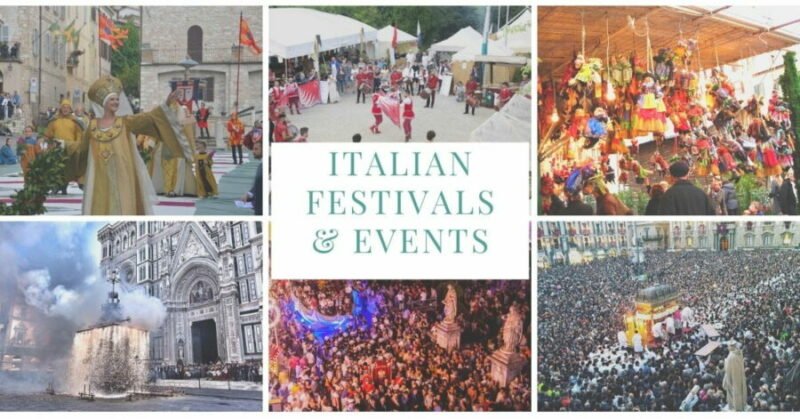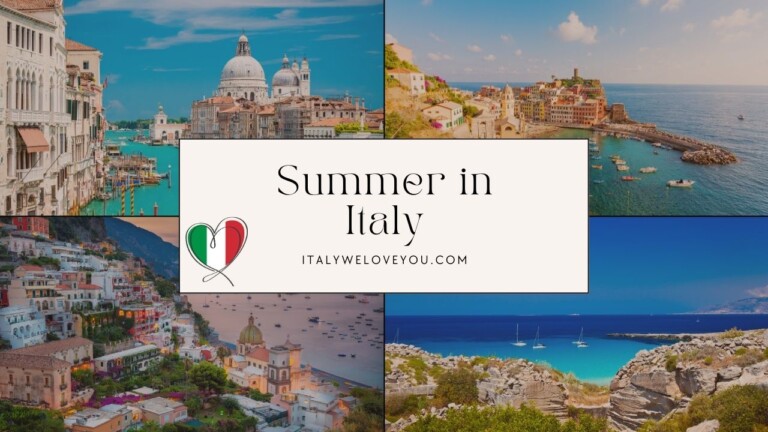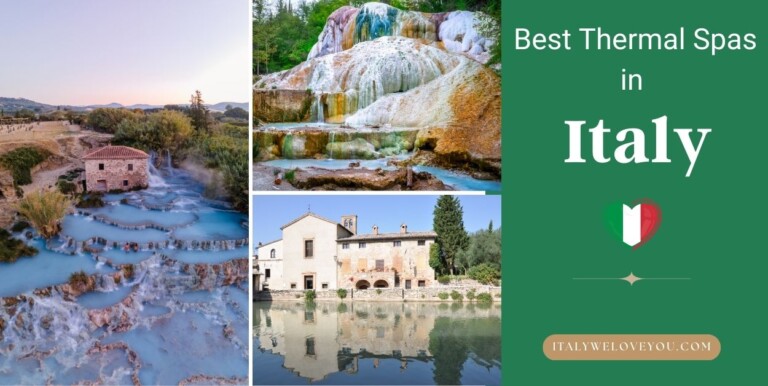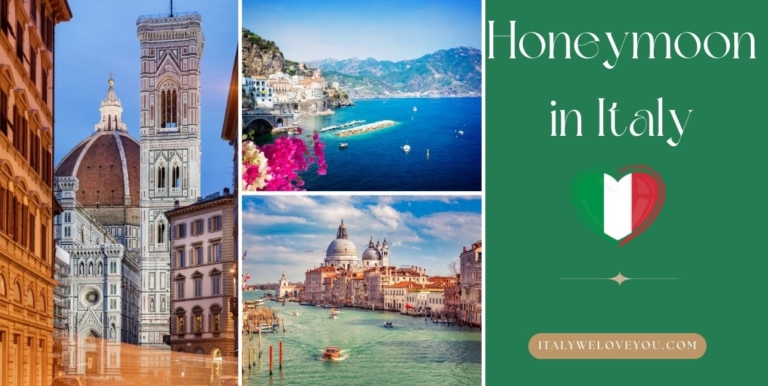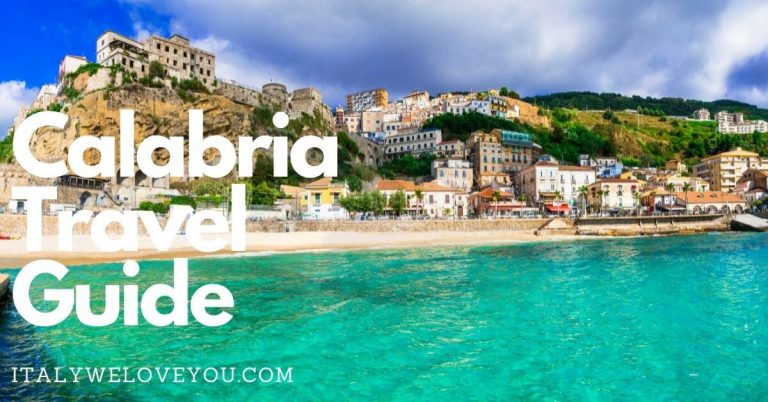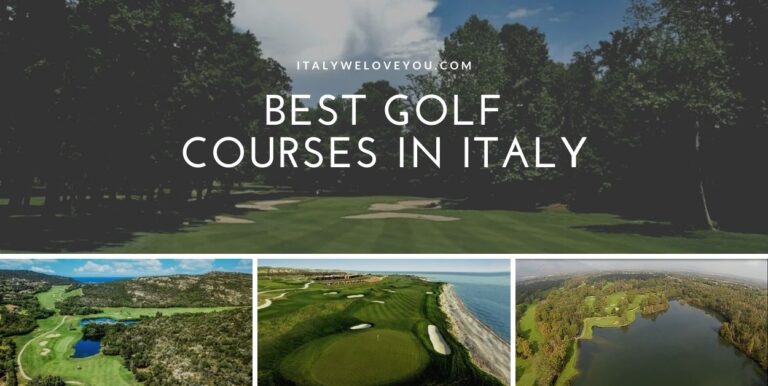11 Italian Festivals & Events You Won’t Want to Miss
Italy is a country with a long history of traditions and cultural events. Participating in these festivals is also the right opportunity to experience truly unique food and wine experiences; traditional events, in fact, always provide for the possibility of tasting typical products or, sometimes, dishes made only for the specific occasion.
Italian festivals you don’t want to miss in 2023
La Befana – Rome
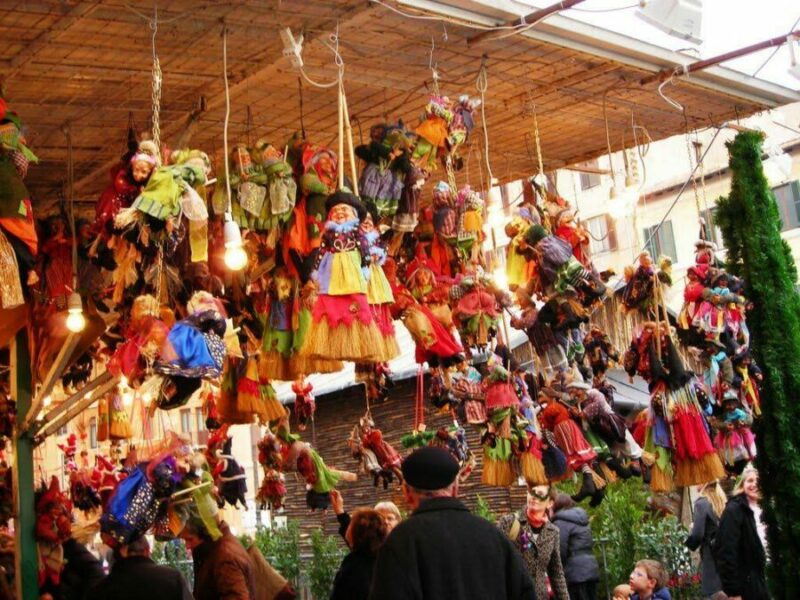
Throughout Italy, the day of the Epiphany is celebrated on 6 January. Epiphany is the feast that in the Christian Church celebrates the first manifestation of the Divinity of Christ, which took place through the visit of the Magi (the term Epiphany derives from the Greek and means precisely “manifestation”). It is a religious event that, as often happens, over time has been linked to the popular and folkloristic figure of the “Befana”: a nice old woman who, riding a broom, delivers gifts, candies, or coal to children. The coming of the Befana bringing gifts to the children recalls the gifts offered to the Child Jesus by the Magi.
What has soon become the “Feast of the Befana” sees its epicenter in Rome, where it is perhaps one of the most popular folkloric festivals felt by citizens. In particular in Navona Square, where there are many stalls with traditional socks full of sweets. During the whole period of the festivities, the main Christmas market in Rome rises in the square and the celebrations traditionally end with the feast of the Befana.
Festival of Sant’Agata – Catania
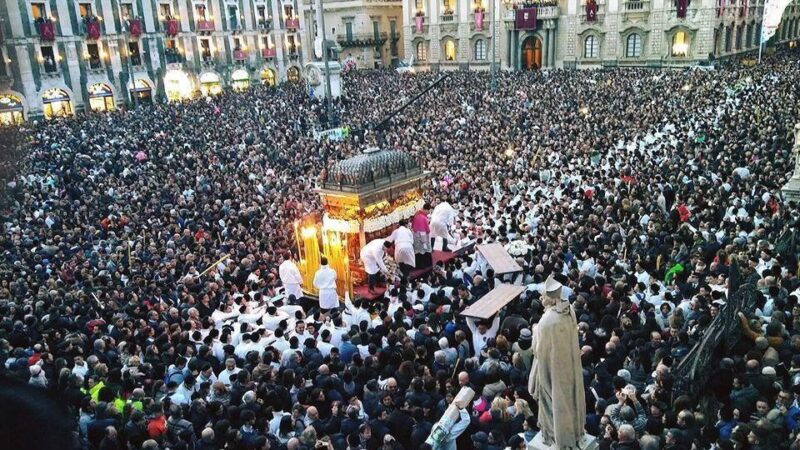
During the celebrations, Catania hosts a huge crowd of devotees and onlookers who gather in the street and in the squares: three days of worship, devotion, folklore, and traditions unique in the world in honor of Saint Agata, the patron saint of Catania. Saint Agata is the protagonist of these celebrations which take place at the beginning of February: the relics of the saint are carried in procession by devotees who wear a kind of white habit and a black bonnet, in a combination of religion and folklore. The first day of the feast is reserved for the offering of candles. A suggestive popular custom is that the candles given are as tall or heavy as the person asking for protection. Two eighteenth-century carriages and eleven “candelore” (large candles representing guilds), are carried in procession. This first day of celebration ends in the evening with a great fireworks display in Duomo Square. The procession of the following day lasts a whole day and ends late at night when the relics return to the Cathedral. On the days of the festival, the traditional Fair of St. Agata also takes place.
Carnival – Venice
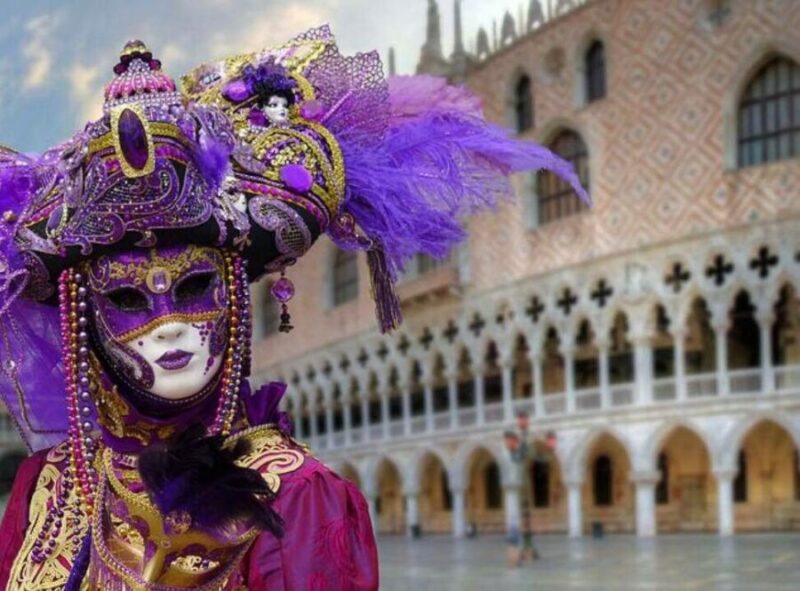
Carnival is certainly one of the most heartfelt and popular celebrations in Italy, but Venice is certainly the place where this tradition reaches its highest point. Here, in fact, Carnival is a great open-air party that lasts two weeks. The Carnival of Venice is certainly the most important event in the lagoon, and the most famous and oldest carnival in Europe: documents attest to the presence of masked celebrations as early as the year 1000. The Doges were able to promote the Carnival to grant the population, especially for the humbler classes, a period dedicated to fun and parties. In the Venice Carnival, the masks guaranteed total anonymity.
While many events, especially masked balls, require reserved invitations or entrance tickets with sometimes prohibitive prices, many others, such as the Rowing of Silence (a suggestive procession of gondolas that cross the Grand Canal, illuminated for the occasion with thousands of candles), concerts and street performances are free and open to the public. The Venice Carnival is a cultural event that attracts thousands of tourists from all over the world. They crowd to the streets of the city to participate in this great party full of colors and fun.
The Burst of The Chariot – Florence
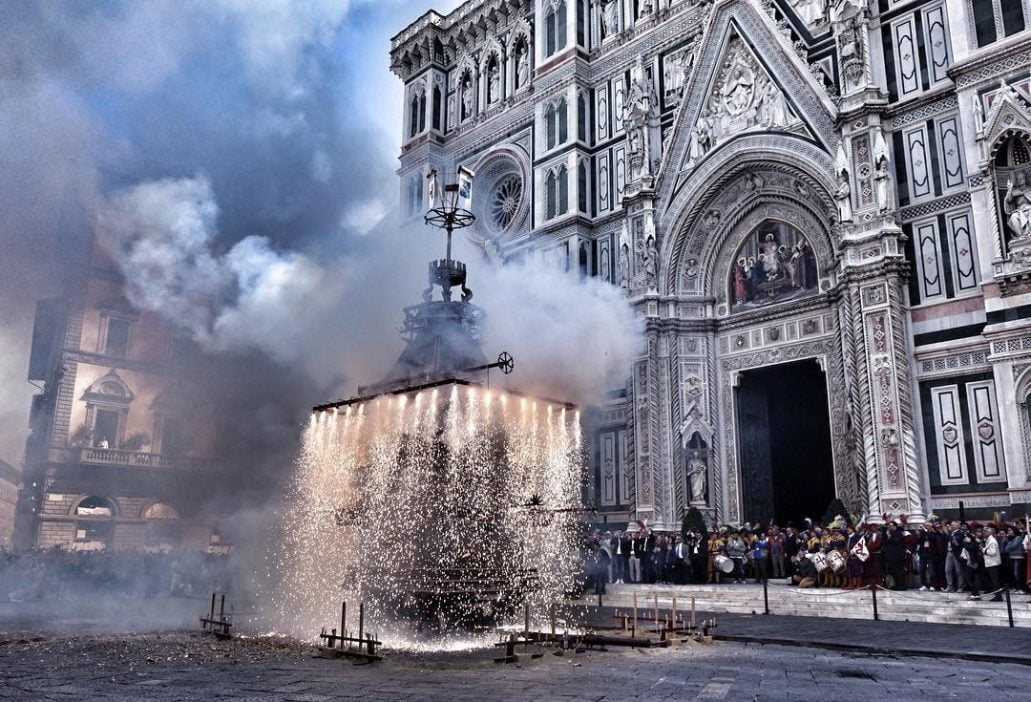
Every year Florence celebrates Easter in a very special way. An elaborate chariot built-in 1622, called “Brindellone”, in the shape of a 2-3 storey high tower, is pulled up to the Cathedral by a pair of oxen adorned with garlands. It is followed by a handful of percussionists, flag-wavers and characters dressed in period costumes, as well as city officials and representatives of the clergy. The chariot, well stocked with fireworks, when it arrives in front of the Cathedral stops and waits for the start of mass.
At the end of the mass, the archbishop starts a dove-shaped rocket (called “Colombina” which symbolizes the Holy Spirit) which makes the fireworks of the chariot shine, which if they light up correctly, will guarantee, as he wishes tradition, a lucky year for the city and its citizens. It is for this reason that every year, everyone hopes for a blowout of the perfect chariot. The chariot gives life to spectacular fireworks that meet the applause of the whole audience.
Calendimaggio – Assisi
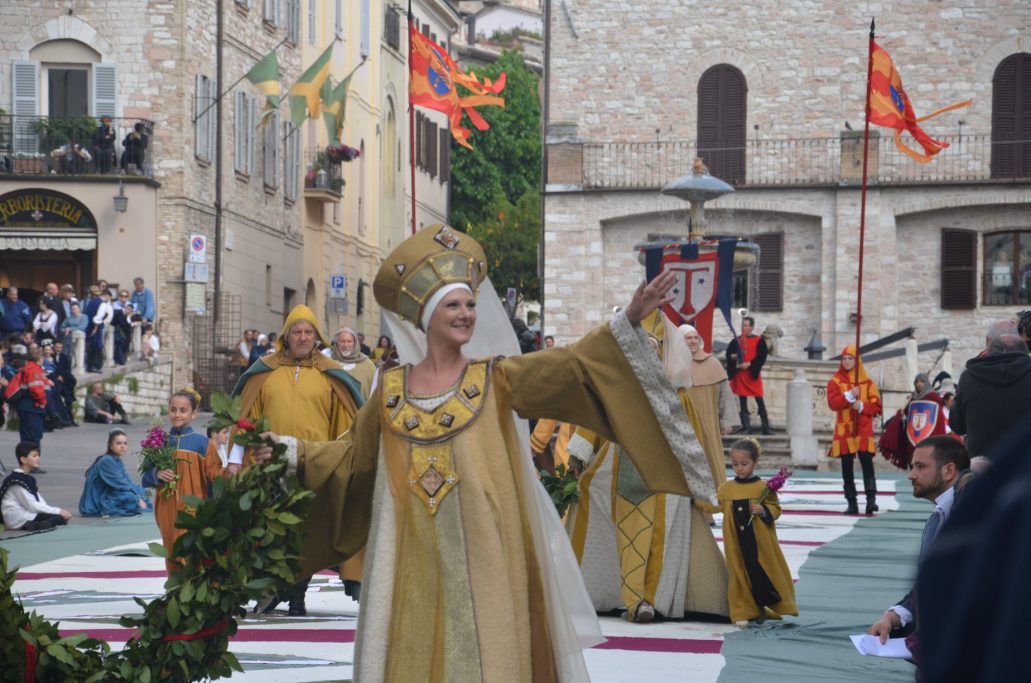
The first weekend of May celebrates the return of spring in many areas of Italy, with a celebration that takes the name of Calendimaggio. The origins of Calendimaggio are lost in time and are linked to pagan customs that celebrated with different rites, but all marked by joy, the return of spring, and therefore the renewal of the cycle of life. In Assisi, the feast of Calendimaggio lasts three days, with processions in medieval costumes and musical performances, which see the two parts into which the city is divided collide with each other. Before meeting in the central square, the representatives of the two parts of the city take part in the “Blessing of the banners”, in the Basilica of Saint Francis and in the Cathedral of Saint Rufino. These are very short but heartfelt religious ceremonies. The challenge consists of three competitions of strength and skill between representatives of the two parts of the city: tug-of-war, cart racing, and crossbow shooting. The part of the city that will have won at least two of the three competitions will be the winner of the challenge.
Le Infiorate – Spello
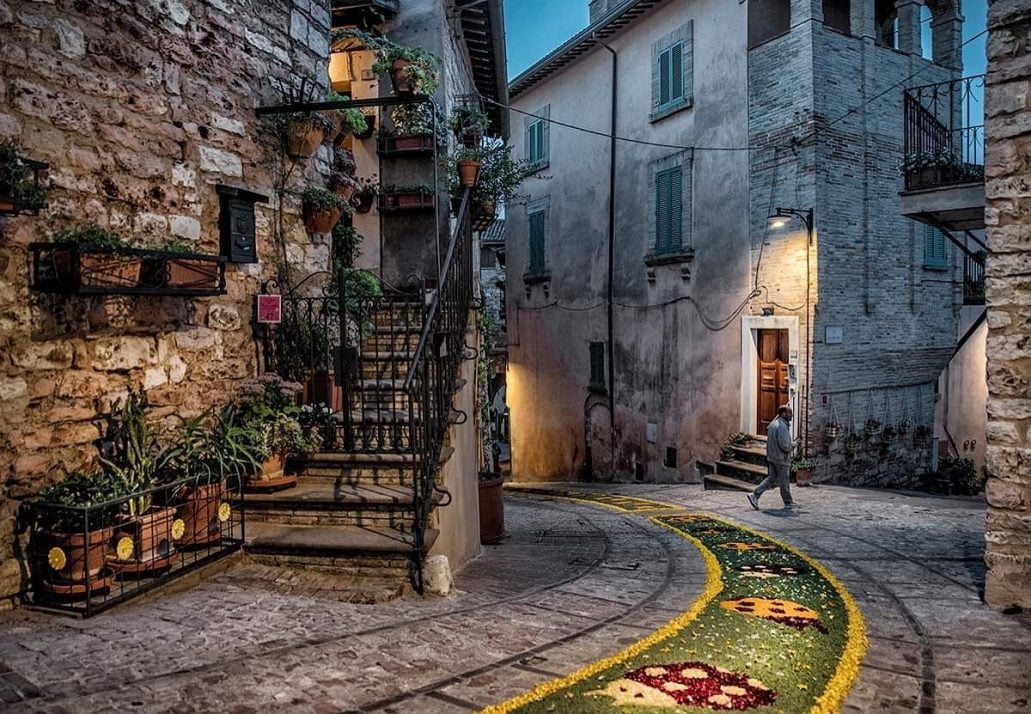
In the medieval town of Spello, near Perugia, every year (usually in June), for the occasion of the religious celebration of Corpus Domini, the so-called “infiorate” are held: about 2,000 square meters of flower carpets and floral paintings are created by numerous artists in the streets of the town center, also with the collaboration of local citizens, working all year round in order to prepare the event in the best possible way. Among the most important and challenging preliminary stages of the event are the search and collection of flowers and then the selection and conservation of the petals. The subjects and decorations are always renewed and are linked to the great tradition of Umbrian painting, from the Renaissance to the 18th century, and sometimes the figurative discourse also opens up to the greatest testimonies of modern art.
These characteristic decorations are called “infiorate” and are a tribute from the inhabitants to embellish the path of the Sunday morning ceremony when the Body of Christ is carried in procession. Numerous visitors arrive in Spello to admire this explosion of colors and scents.
Medieval Festivals – Brisighella
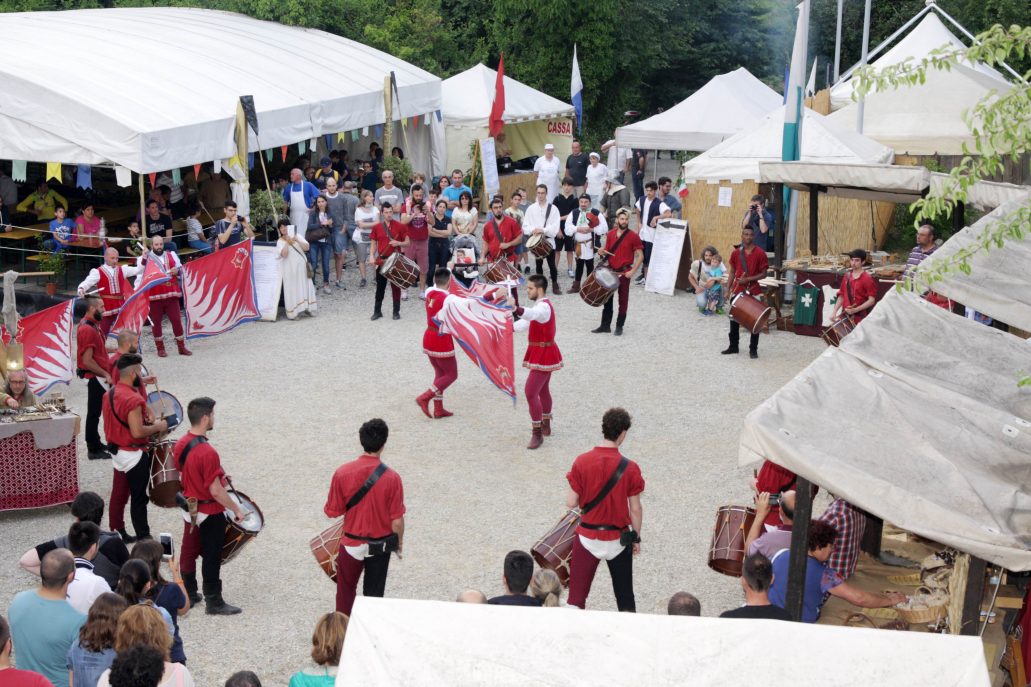
During four days in June, in Brisighella, a village in the province of Ravenna perched on a hill 115 meters above sea level, the Medieval Festivals are staged, with historical re-enactments, tournaments among knights, guided tours in costume, craft markets, and exhibitions of ancient crafts, medieval music, falconry shows, all set against the backdrop of the Manfredi fortress. A colorful crowd of nobles and knights, artisans and musicians, soldiers and peasants, animates the festival, which brings to life the ancient crafts, traditional costumes, clashes among knights and the shows of storytellers. On Saturday, at dusk, the re-enactment of an assault on the fortress takes place, which ends on Sunday in the late afternoon. Obviously, at the Medieval Festival of Brisighella, a medieval tavern is also set up, with dishes and flavors cooked according to ancient recipe books with daily menu variations.
Feast of Saint Rosalia– Palermo
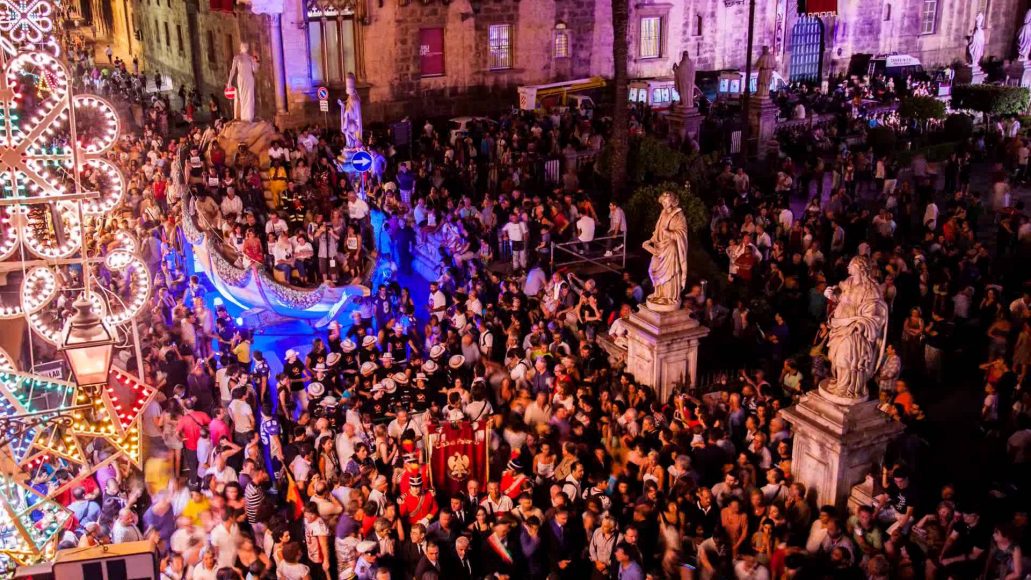
The feast of Saint Rosalia is a tradition full of charm and beauty, among devotion, dance and theater. Saint Rosalia, particularly dear to the people of Palermo, in Sicily, for her role in the fight against the plague in 1624, is the absolute protagonist of this great event of popular culture, whose spectacular procession takes place in the most beautiful places in Palermo halfway through July. The traditional historical procession, in a mix of folklore and religion, finds its culmination in the traditional fireworks. An authentic treasure trove of traditions, the Feast of Saint Rosalia, patron saint of Palermo, is an event that attracts tens of thousands of tourists to the city. During the celebrations, dishes that are part of the popular Palermo tradition are eaten: pasta with sardines (called pasta chî sardi), babbaluci (boiled snails with garlic and parsley), traditional focaccia (‘u sfinciuni), boiled octopus (‘u purpu), roasted chickpeas and pumpkin seeds (‘u scacciu), boiled corn on the cob (pullanca) and watermelon (‘u muluni).
Night of the Tarantula – Salento
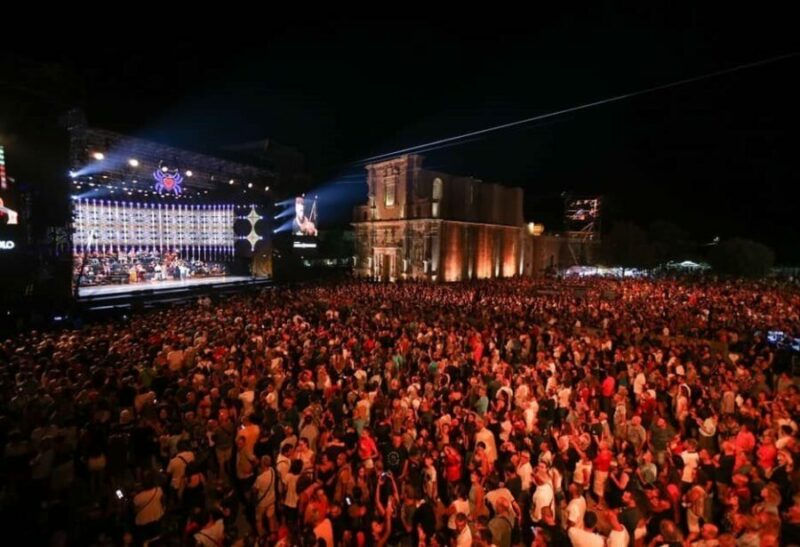
It is the largest Italian music festival dedicated to traditional culture and, in particular, to the enhancement of the popular music of Salento, in Puglia, and its fusion with other musical languages, from world music to rock, from jazz to symphonic music. The goal is the recovery of a dialect, a food, a tradition, a dance, music, all part of the history and origins of that particular people and involves thousands of tourists every year.
It takes place in various stages that ends with a great concert that is held every year in the town of Melpignano (in the province of Lecce), in the heart of Salento, and which attracts about two hundred thousand spectators ready to dance to the rhythm of the “pizzica-pizzica”, a popular dance similar to the typical “tarantella” of this area. The concert brings back to life the typical music of the region: a lively dance that has its origins in the ancient healing rite from the “tarante”, that is, from those who, bitten by tarantula (a small spider), they entered in a state of shock and general malaise, from which they awoke only with music.
Peperoncino “Chili” Festival – Diamante
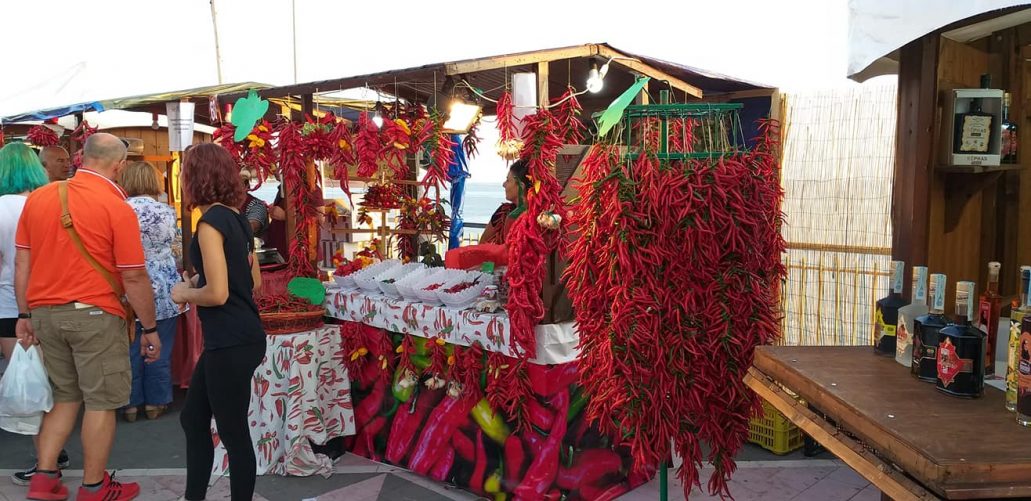
This event manages to transform every year, for five days, the suggestive seaside town of Diamante, in Calabria, into the world capital of chili, where you will not infrequently see terraces and balconies embellished with chili pepper necklaces. The Chilli Academy was also founded in Diamante to spread and deepen the culture of chili and its use in gastronomy, but also in cosmetics, pharmacology, and medicine.
Read Also: Things to do in Calabria
Chilli, but not only: in the street and in the squares, in fact, also lots of music, shows, street artists and thematic exhibitions. In the historic center and along the seafront, restaurants offer spicy menus. The Chili Festival is also an opportunity to discover the beauty of a country that hosts numerous murals and immerse yourself in a suggestive atmosphere. In fact, Diamante in the last years has seen painters and artists arrive from all over Italy and from beyond the borders and has come back to life. In the maze of narrow streets and stairways, Diamante has become a sort of open-air art gallery, with over 200 murals, among large painted walls and poems written on the walls.
Grape Festival – Marino
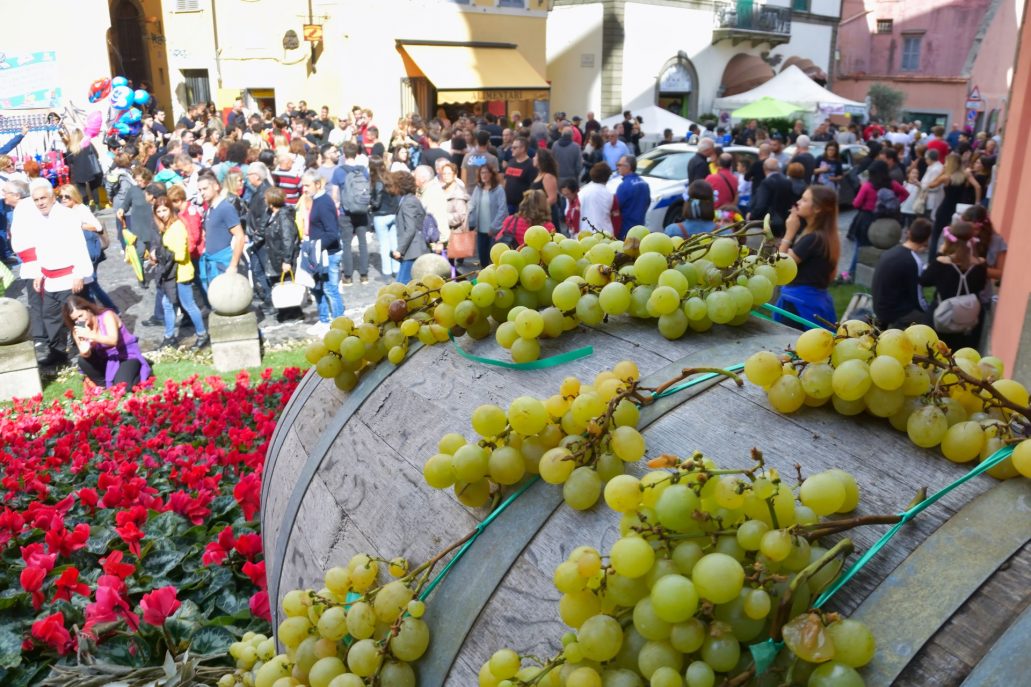
The oldest Grape Festival in Italy was born in 1925 and is held every year on the first Sunday of October in Marino, a town located near Rome, known throughout Italy for its winemaking tradition as the home of “Marino” DOC white wine. This festival is proud to be one of Italy’s oldest wine festivals. Its main purpose is to promote the local wine product of the same name.
In the afternoon of the eve you can attend a historical re-enactment with figures in sixteenth-century costume (the first edition was held in 1929), while on the day of the event there will be a procession, parades of allegorical floats, a historical procession and the famous “miracle of the fountains that give wine ”, what probably made this event so famous: from all the fountains in the town, wine flows instead of water for almost an hour, while allegorical floats parade through the streets of the town centre. In this folkloric triumph, the distribution of grapes from balconies and allegorical floats to the crowd also takes place.

